Related Content
Content
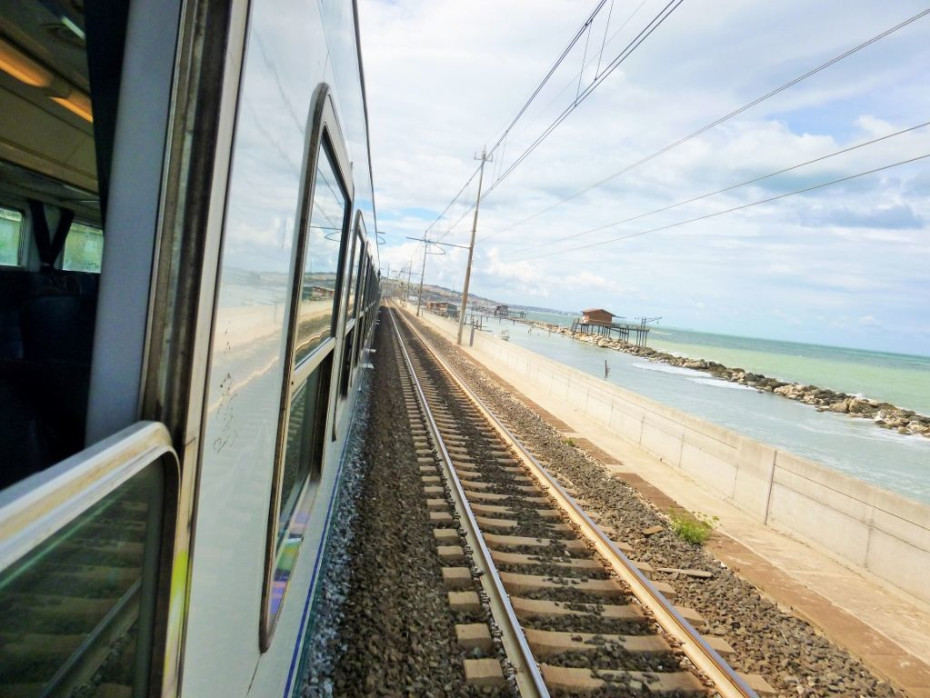
Episode 21: The Adriatic Coast and Perugia
A thrilling day trip from Bologna to Ancona and Perugia, once I'd worked out how to board the train
Share
It won’t by now be a revelation to discover that beaches, chilling out poolside, or hurling myself down a mountain aren’t near the top of my holiday wish lists.
Instead my ideal holiday experience is to take a series of simple day trips by train to eternally beautiful locations and that’s partially why Bologna is a fave destination.
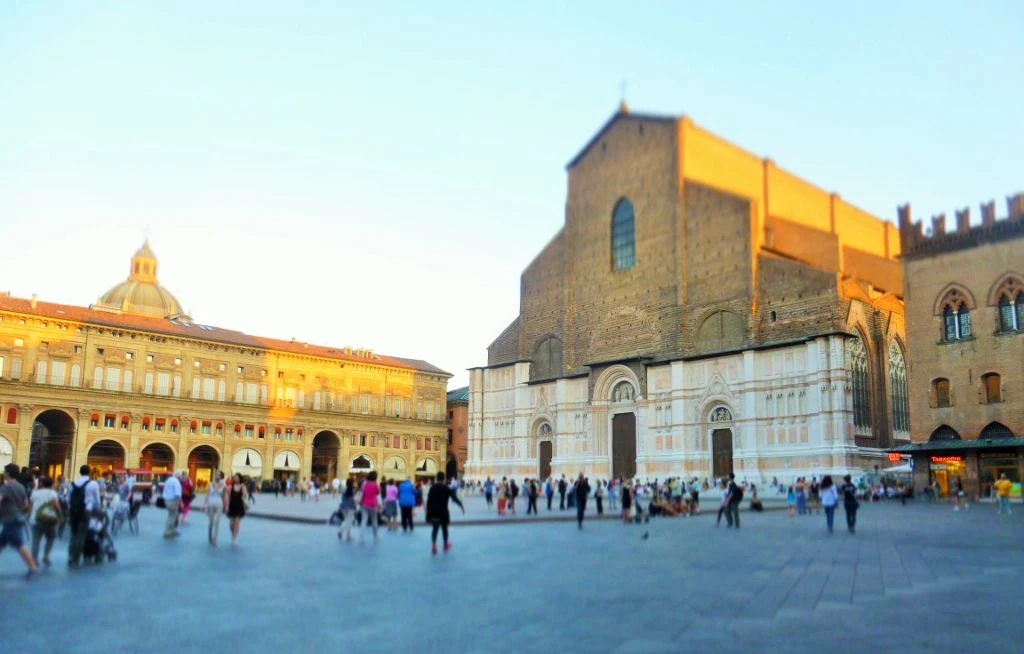
A rail based holiday, while keeping the accommodation hassle to a minimum by staying in one location is I think one of my better ideas, hence these suggestions for doing just that.
But Bologna is particularly special, it’s a key railway junction on the Italian rail network, but it’s more beautiful than the likes of Bakersfield, Crewe and Mannheim and other towns and cities with a similar status in other countries
Though Bologna’s loveliness is arguably eclipsed by even more fabulous locations that are within very easy reach by train, but its room rates and restaurant prices also compare favourably with the other more popular Italian cities.
Hence taking my mum there for five blissful days on which we ventured to Modena, Parma, Venice and Florence.
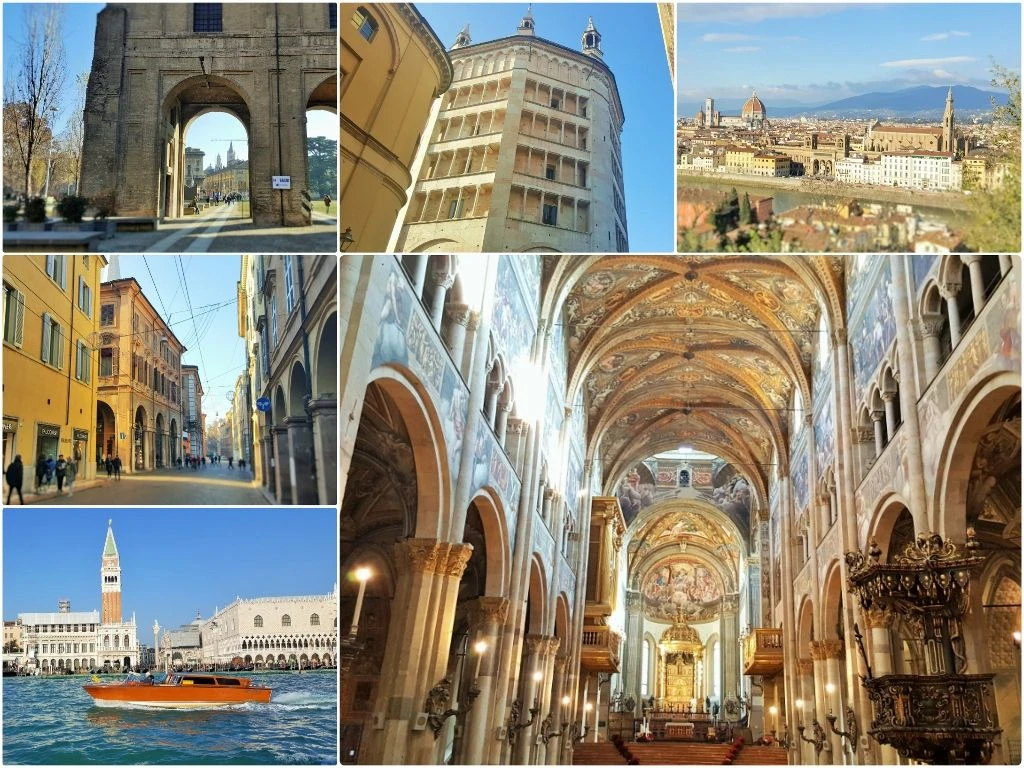
Making sense of Bologna's multi-part station
What can also send me into raptures are impressive railway engineering achievements, as I’m always slightly in awe of how they can even begin to be constructed because mathematics and technical drawing were two constant negatives on my school reports.
Bologna Centrale’s extension to accommodate the arrival of a high-speed railway at the station is indisputably awe-inspiring.
On a return visit to Bologna my mum, for the first time in her life said ‘wow’ inside a station, but Bologna Centrale astonished her, she couldn't believe a station could look anything like this!
The primary conundrum when purpose building a brand high speed railway is how to provide the access to and from the trains.
The four solutions for the where to put the stations paradox, are:
(1) Find a suitable field miles away from the town and city and expect people to find the prospect of taking a high speed train so alluring that they’ll drive somewhere in order to board one, while giving scant attention to how these locations can be accessed by public transport.
(2) Construct a separate, bespoke station in a city that’s solely or mainly for the use of the high speed trains, but strive to place it in a near, but yet so far, location to an existing station.
The likes of Lille Europe, Stratford International and Valencia-Joaquin-Soralla are in this category.
Or failing that somewhere in the city that doesn’t have easy access to other trains or existing public transport will have to do.
Despite its shortcomings, the HS2 in Britain is taking this answer to a city centre solution at Birmingham Curzon Street.
(3) Accept that rebuilding an existing major city centre station, so that it can also now also be on a high speed line, is too problematic.
Therefore compromise by accepting that the high speed trains will have to trundle in and out of stations on the railway tracks used by standard trains.
Most of the European city centre stations used by high speed trains come into this category.
(4) Create an extension to a city centre station, so that the high-speed trains can share the same station as the existing trains, but also be kept apart from them, so that those conventional trains can’t cause delays, or generally get in the way.
This solution is usually prohibitively expensive as smashing a high speed railway into the heart of the city requires miles of tunnels as at London St Pancras, Paris Montparnasse and Torino Porta Susa, or the Japanese method of miles of viaducts as used in Tokyo, Nagoya and Kyoto.
In Bologna just to the north of its main railway station, there was space that had become little used by trains, but which hadn’t yet been exploited as a location for a hypermarket or a sports centre.
The high-speed line could have been squeezed into this space up at ground level beside the existing station, but there wasn’t also the room for platforms to be built for the sole use of the high speed trains.
Despite that, this was a rare opportunity for high speed trains to also use the exact same locale as the other trains to and from Bologna, so it had to be taken advantage of.
So the solution was to cut an enormous box into the ground, beneath the defunct railway lines beside the station and to put the high speed line in the box.
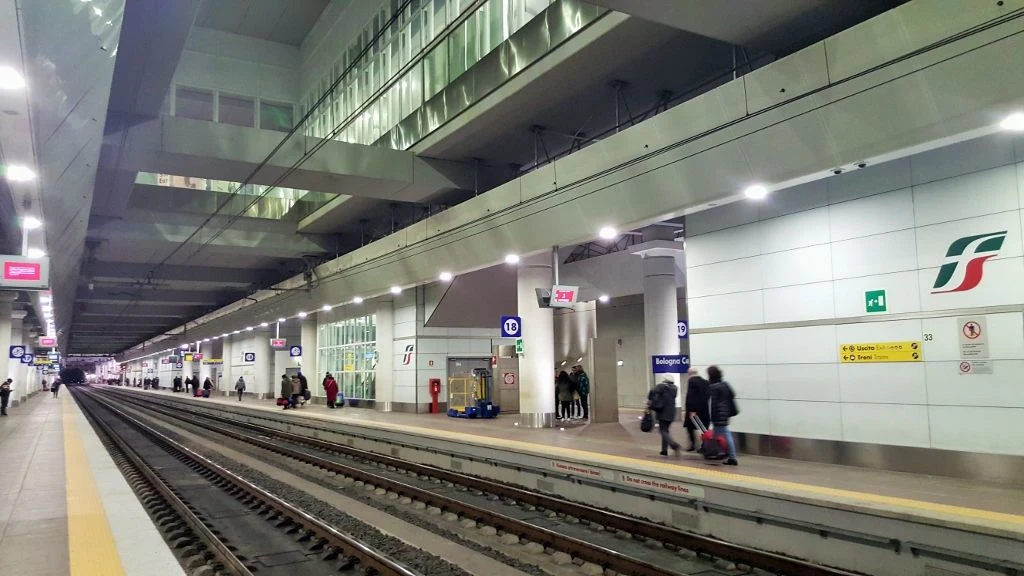
The trains could then either, call at this extension to Bologna Centrale station, providing interchange with all of the other trains to and from the city, or race through the station on their dedicated high speed tracks
The extension to Bologna Centrale would therefore have to be both enormous and located underground, but it would also be right beside the existing station, which also happens to be the key hub of the Italian railway network
The end result can’t help being literally amazing, but for the time being I was blissfully ignorant of the fact.
On the previous day the Frecce train I’d taken from Padova, which had commenced its journey In Venice, still used the older part of the station.
Then when I was back at Bologna Centrale the next morning, while I was awaiting my train in the older part of the station which is in the open air, I wasn’t aware that metres away from me, high speed trains were racing through the city.
One of Europe's best coastal rail journeys
I was exploiting Bologna’s location as the key hub of the Italian rail network to see as much of the country by train as I could in three days and travel without heavy luggage.
First up was a route I hadn’t travelled before, but had long been on the bucket-list, namely the rail journey along The Adriatic Coast.
This route tends to be eclipsed by other train lines by the sea, such as some parts of the journey around The Mediterranean, but trust me, it’s wonderful.
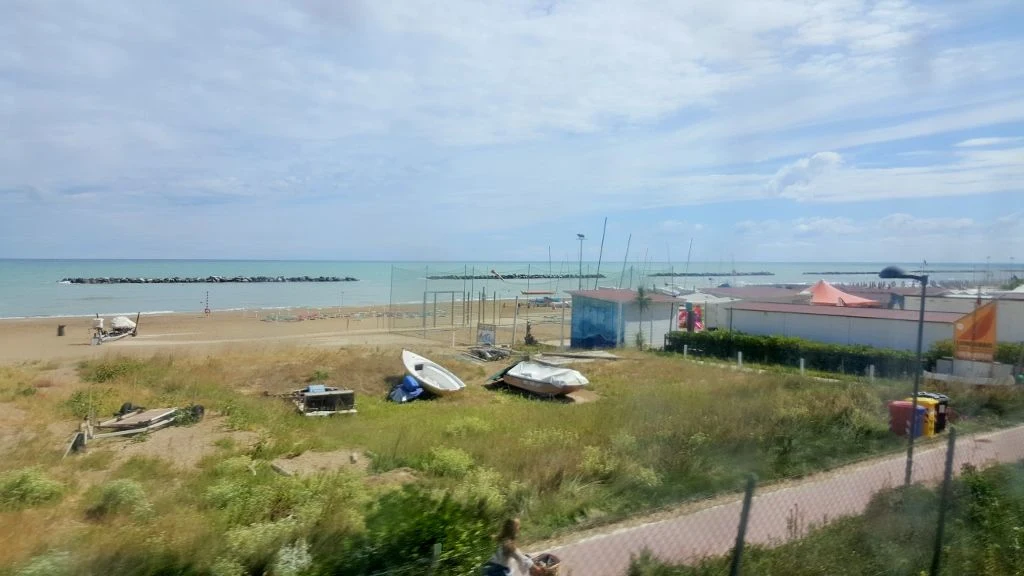
I’d avoided the rail pass fees charged on the Frecee trains by taking an InterCity train and guessing correctly that on a Tuesday, seats wouldn’t be hard to find.
But I now regret not rising earlier to take the 08:00 departure south, so that later in the day, I could have gone on to explore Perugia between trains.
And also I regretted that my itinerary for the day wasn’t taking me further south than Ancona because on a perfect day for train travel, the sea views south of Rimini were fabulous.
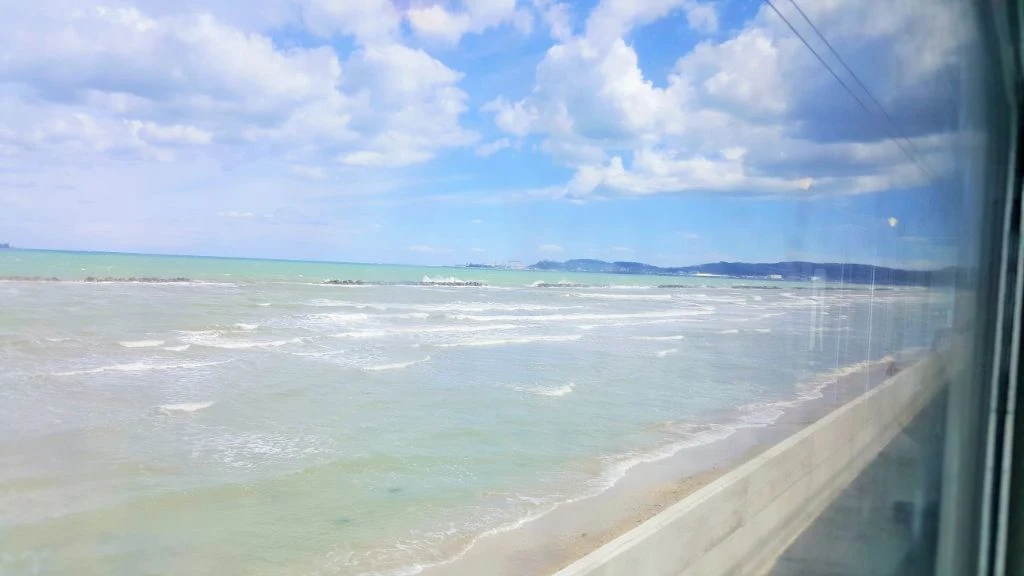
I was travelling in a part of the train in which the seats were in compartments, but the corridor was facing the coastal side of the railway.
What was charming was that my fellow travellers sat in the other compartments, gradually began to realise that a glorious travel experience was available if they left their seats and stepped out into this corridor.
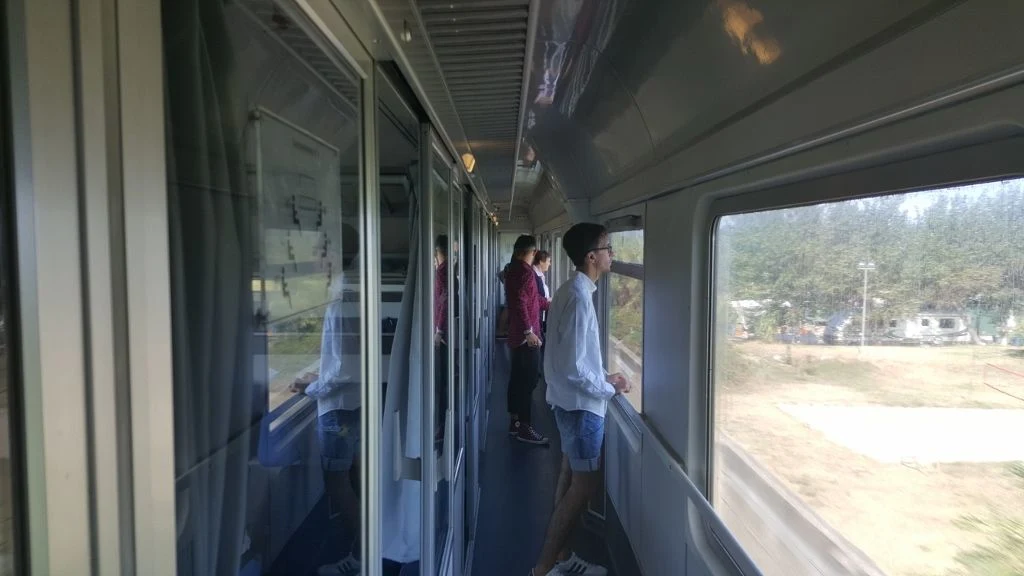
A lunch in Ancona station
The coastal scenery wouldn’t be the only revelation of the day’s adventures, I had more than an hour to make the connection in Ancona, so I spent the time having an early lunch in the Trenitalia staff canteen.
It was adjacent to the main station building and the signs pointing the way to the restaurant led me to it.
At first I thought I’d made a mistake and was anticipating a polite tap on the shoulder and a request to leave, but the serving staff beckoned me to hand over my plate so that they could pile it with food.
I wasn’t hungry, but knew that catering wouldn’t be available on any of the trains I’d be taking for the remainder of the day, so as opportunity had knocked, I took full advantage.
Needless to say it ticked all of my boxes, bargain-priced food while watching the trains go by, wonderful.
Decent food can be harder than you might imagine to track down at Italian stations, but I haven’t encountered this Ancona canteen arrangement anywhere else.
On to Perugia
The third delightful surprise of the day was the scenery on the journey westwards across Italy. I guessed right that a route through the Apennines would be fairly wonderful, despite its lack of scenic route markings on the European Rail Map.
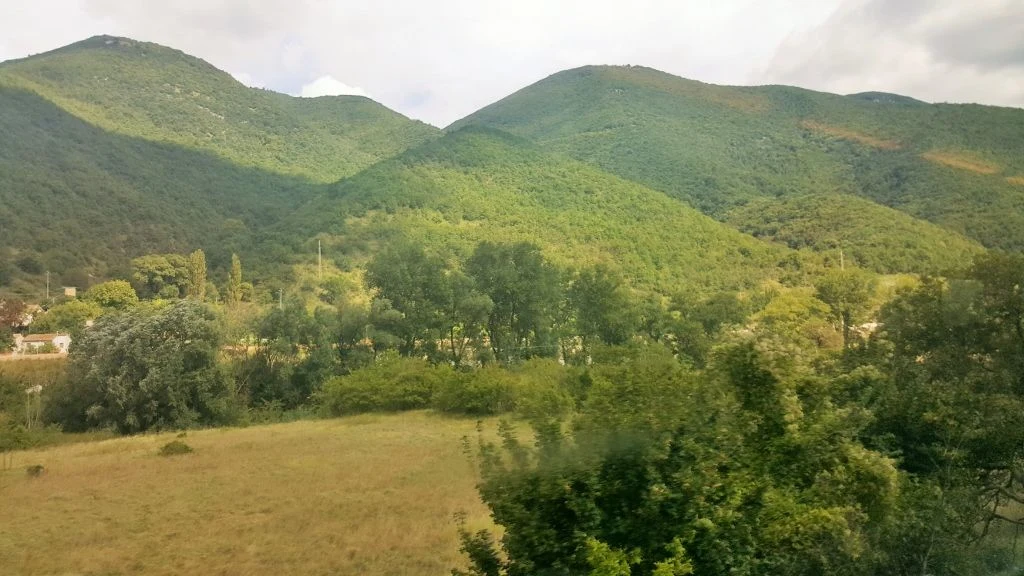
An easy change of train at Foligno enabled me to head north on the surprisingly sparse rail service to Perugia via Assisi.
In Austria, Britain, Germany or Switzerland, tourist magnet destinations within a day trip distance from a capital city would have at least a train every two hours, but south of Florence, the Italian train frequencies can be sparser than you might expect on the non-high speed routes.
From the right of the train as it passes by Assisi there is a splendid view of the Basilica of Saint Franicis, but it was being doused by a brief thunderstorm when I passed by.
Good friends of mine are drawn to beautiful Perugia like a moth to a flame, but the vicinity around its station is a total anti-climax, with cars racing along the main road out of town.
I had an hour to wait for my next train, so contemplated whether to risk a spontaneous bus ride, the station is some distance from the city centre, but decided against it.
So I found myself idling on the platform, with my book, Italian Ways by Tim Parks was my well-chosen companion for this part of my adventure.
Then something moving across the train tracks to the north of the station caught my attention. At first I thought it was some sort of industrial machinery, big metal buckets for carrying heavy loads between factories across the railway line.
Then when I looked again I thought I could see people inside these metal pods, which looked something out of The Jetsons.
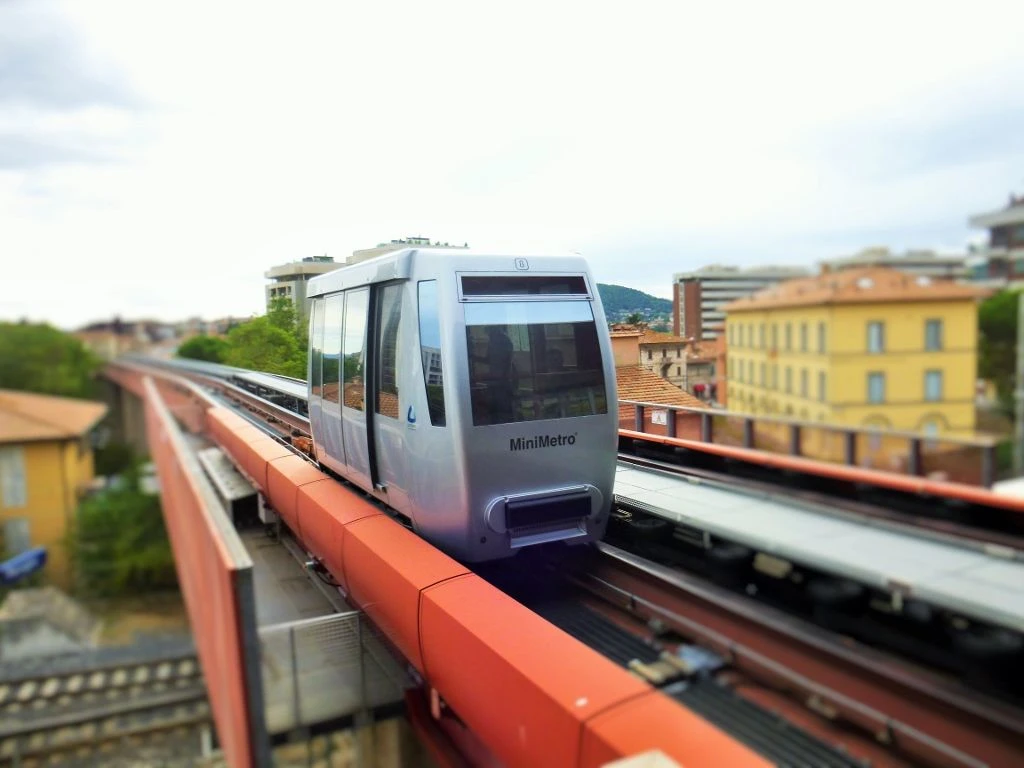
I moved closer and discovered that my spectacles weren’t letting me down, because Perugia is home to the rather wondrous MiniMetro people mover.
Its Fontivegge station is a 2 minute walk from the main station in Perugia and it provides the quickest and easiest means of accessing the historic heart of the city.
It would have been wonderful to travel to its final stop, but by now I only had time for a two station hop, but of course I had to take at least a short ride!
The MiniMetro station is called Fontivegge because the main station in the city used to be named ‘Perugia Fontivegge’ and it might just be a good idea if it reverted to the name.
That’s because when heading north to the city on trains from Assisi and Roma, before they arrive at Perugia station, they call at a station named ‘Perugia Ponte San Giovanni’, this is a large-ish station that I suspect many unwary travellers mistake for the city’s main station.
An easy interchange at Arezzo into an InterCity train returned me to Bologna on schedule and all of the five trains I’d taken that day had been on time.
In my experience Italian daytime trains are overwhelmingly punctual, but ironically it’s the high speed trains which seem most prone to delay.
Of the 17 trains I took in Italy on this trip, only two were delayed during their journeys, both of which were Frecce trains.
On holidays spent in Vicenza and in Bologna where day trips were taken by train pretty much every day, all of the Regionale trains that we travelled by were on time.

Simon Harper
I wanted to share my passion for train travel and explain how anyone can take the fantastic journeys I have taken.

This is one of more than 100 train travel guides available on ShowMeTheJourney, which will make it easier to take the train journeys you want or need to make. As always, all images were captured on trips taken by ShowMeTheJourney.
This second version of ShowMeTheJourney is exciting and new, so we are genuinely thrilled that you are here and reading this, but we also need your help.
We’re striving not to let anything get in the way of providing the most useful service possible, hence a facility has been set up with DonorBox which can be used to support the running costs and make improvements.
Instead of advertising or paywalls, your financial support will make a positive difference to delivering an enhanced service, as there’s a lot of ideas which we want to make happen.
So if you have found the info provided here to be useful, please consider saying thank you.



